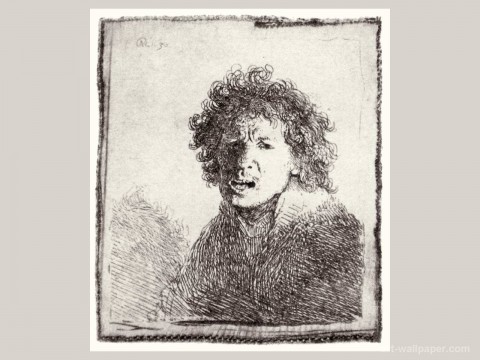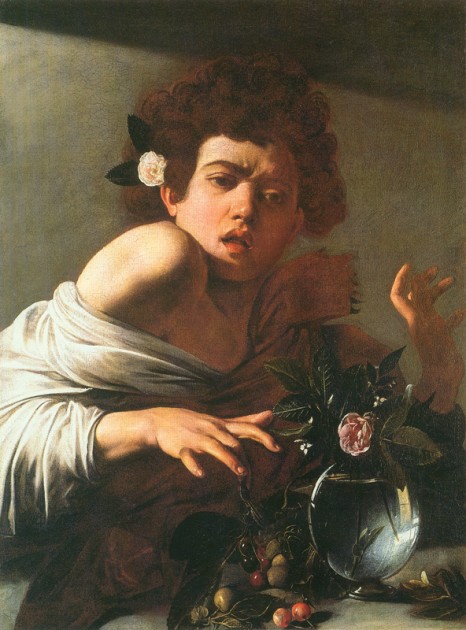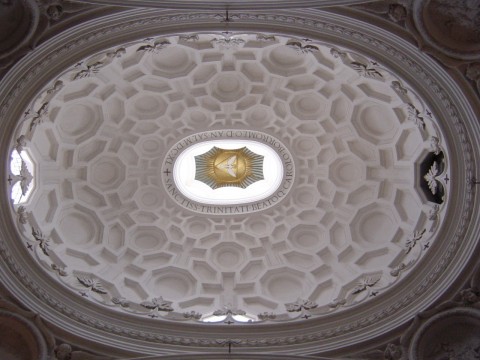Wednesday, February 6th, 2013
The Open Mouth in Baroque Art
This morning I’ve been thinking about how a lot of Baroque art depicts figures with open mouths, or partially-open mouths. Since the Baroque period involved a heightened interest in emotion and psychological reactions, it’s not surprising that artists would be interested in exploring the human emotions that are conveyed through this specific composition.
Jean H. Duffy explains how the open mouth can convey multiple emotions at the same time, including pain, ecstasy, and fear.1 Caravaggio was well known for depicting figures with open mouths, including his famous Boy Bitten By a Lizard (see above) or David with the Head of Goliath (both the version in the Borghese Gallery and the version in the Kunsthistorisches Museum in Vienna). and The complexity of such expressions no doubt were appealing to Baroque artists, who often were continually interested in the idea of mingling emotions. Perhaps the open mouth motif and its varied effects are a nice compliment, then, to the ways that Baroque artists tried to mingle other aspects of their art, like the tendency to mix artistic mediums.

Bernini, detail of "The Ecstasy of Saint Theresa," 1645-52. Cornaro Chapel, Santa Maria della Vittoria, Rome
Howard Hibbard also weighs in on the discussion of the open mouth, particularly when he discusses Guido Reni’s Immaculate Conception (1627, Metropolitan Museum of Art). Hibbard finds that the open mouth imagery can relate to Counter-Reformation sentiment. He writes, “Mary’s mouth, like those of the angels, is partially open, as if voicing a prayer or supplication. The revelation of human warmth and frailty – the humanization of the divine – is a characteristic of seventeenth century art and Reni was one of the innovators.”2 The humanization of figures like the Virgin and saints were important at this time, especially as the Catholic church sought to make such figures more approachable and relatable to a lay audience. In addition to Reni, the sculptor Bernini often depicted his figures with open mouths, most notably seen in The Ecstasy of Saint Theresa (see detail above).
This topic of open mouths has got me thinking quite a bit, and I wonder if there can even be some parallels made with Baroque architecture. The shape of a human’s open mouth seems to have parallel with the ovals that Borromini and Bernini utilized in their architectural spaces. I think the irregularity of the oval lends itself to the emotion and perhaps vulnerability that is found in the open mouth of a human. The oval is also a more dynamic shape than the circle, which adds to its expressive features.
I’m sure that these musings on the open mouth and oval shape are going to influence the way that I interact with Baroque art and architecture in the future. I’m curious to see whether I feel like I’m walking into a gaping mouth the next time I step into Bernini’s piazza outside of Saint Peter’s (1656-67)!
What depictions of open mouths (or oval shapes) do you like in Baroque art? Do you know of any other theories for why the open mouth would have been preferred during the Baroque era?
1 Jean H. Duffy, Reading Between the Lines: Claude Simon and the Visual Arts (Chicago: University of Chicago Press, 1998), 261. Available online HERE.
2 Howard Hibbard, “Guido Reni’s Painting of the Immaculate Conception,” Metropolitan Museum of Art Bulletin (1969): 28.



What I do know is that there are various Hellenistic Greek sculptures that use open mouths or visible teeth, in particular some of those showing dying figures, those in extreme circumstances (like Laocoon and the Polyphemos from Sperlonga), infants, and grotesques (like the drunken old woman). Unsurprisingly, these are also often among the works of that period termed “baroque”.
Hello Terrence! Thanks for your comment. I like that you mentioned the Laocoon. It makes a lot of sense that the Hellenistic period is called the “ancient Baroque.” Just like in the Baroque period, Hellenistic artists were interesting in conveying drama and emotion, as is epitomized in the “Laocoon.”
Michael Savage just emailed me a link to a post that he wrote in response to my post. He does a very nice job of linking the open mouth tradition to the Renaissance, and also mentions the excavation of the “Laocoon.”
http://grumpyarthistorian.blogspot.co.uk/2013/02/open-mouths.html
@dcbyron on Twitter mentioned Bernini’s “Damned Soul” (1619) as an example of an open mouth in Baroque art. This is a great example!
http://rdjess.files.wordpress.com/2012/06/3608op148au6001.jpg
In late medieval art, too,open mouths with tongue and teeth occur: in this rare terracotta Mater Dolorosa for instance, made for Burgundian court. This might be seen within the context of that time’s devotional desire to be as close to a holy person as possible; there are many texts and prayers that testify to this intense longing. By making the Virgin so realistic that she appears a real person, this longing was met to some extent. You can’t really see it in this photo, but believe me, I’ve seen the statue in real life and it is possible to see her teeth …. http://www.rtvnh.nl/data/thumb/abc_media_image/109000/109857/w454.f6c80_fedb9abceda542801f2193dc2547983e.jpg
Interesting post! Emotion seems heightened in the Baroque… there are so many examples – especially in the Spanish Baroque, with its many anguished figures of Christ and the Saints.
As other have mentioned, I would also submit that this transcends the Baroque, including the examples from antiquity to the Renaissance and Mannerism.
Another aspect is the type of emotion expressed – it is nice to find examples that are less extreme than agony or ecstasy! A little more rare before the 17C were depictions of positive emotions, particularly laughing – but they can be found. Two of my favourite examples come from the Renaissance, which show a more natural/positive emotion: Desiderio da Settignano’s “Laughing Boy” [c1460s] and Caroto’s “Young Boy Holding a Child’s Drawing”.
Perhaps the most influential “open mouth” from the [High] Renaissance is Leonardo’s study for a soldier from the Battle of Anghiari, adapted by other artists in depictions of Medusa for shields and decorations.. including Raphael and (later) Caravaggio.
H
Thanks for the comments, Hasan and MJJ!
MJJ, I’m really intrigued by this idea of realism and intense longing. Do you happen to know of any texts where I could read about this intense desire to be as close as possible to a holy person? (I assume it can tie into the desire to go on pilgrimages at this time.)
I can see how such closeness would be heightened in the realism of a polychromed statue, too. I’ll have to look up more images and see if I can get a spot of the Virgin’s teeth!
Hasan, you should check out the Grumpy Art Historian link that I mention above. You can see some good images of some of the very pieces that you mentioned!
The open mouth definitely appears in a lot of art before the Baroque period. I’m even reminded of the gaping mouths of demons from the tympanum of the Last Judgment at Autun (Romanesque period). It is interesting to see, though, how popular the open mouth is in Baroque compositions. If one did a study, I wouldn’t be surprised if they found many more open mouths in Baroque art than in several of these other periods (with perhaps the Hellenistic period being the closest rival?). But then, of course, I make such an assumption because I’m biased toward the Baroque!
What do you think of the idea that Caravaggio’s painting is an attempt to use visual sense perception to evoke other sense perceptions, namely the pain of being bitten (touch) and the cry of the boy (sound)? In which case the open mouth represents what is about to come out of it, a sharp cry of pain. (The Laocoon gives the same effect).
Hi Paul! I think that is a very compelling idea. Since Baroque art is all about the mixing of artistic mediums, it makes sense that the art should also include a mixing of sense perceptions (sound, sight, etc.). This sensory aspect can even extend to Renaissance art, too. I just heard a presentation at CAA which argued that depictions of Mary Magdalene with her jar of perfumed oil could have had connection with the senses, particularly that of smell.
I also came across a depiction of Raphael’s “Saint Margaret” which is a fantastic depiction of an open mouth!
“Saint Margaret” by Raphael. Probably best example of an open mouth in painting: http://uploads3.wikipaintings.org/images/raphael/st-margaret-1518.jpg and http://media.tumblr.com/tumblr_lnzrz8trsg1qggdq1.jpg. The mouth seems quite reminiscent of female anatomy to me, but I think that’s probably appropriate since Saint Margaret is the patron saint of childbirth (since she came out of the innards (“womb”) of the dragon).
On Twitter, Mark Shepheard shared some great links to other depictions of open mouths in architecture. I especially like the Sacro Bosco. I’m copying some of his thoughts and tweets below:
Sacro Bosco, Bomarzo pic.twitter.com/apwsKVfl
Also used in set designs: eg Burnacini’s sets for Il Pomo d’Oro, Vienna 1668 http://bit.ly/Y8sRjd pic.twitter.com/8mB74f4l
Palazzo Zuccari in Rome. I love the inclusion of the windows as part of the motif pic.twitter.com/dGY4PKkN
Another good (and somewhat unexpected) example of open mouths in Baroque art: Rubens’ crocodile and hippopotamus from “The Hippopotamus Hunt” (sometimes called “The Hippopotamus and Crocodile Hunt”) from c. 1615-1616:
http://0-www.britannica.com.libra.naz.edu/bps/media-view/13913/1/0/0.